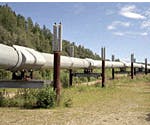About 80 workers are battling to clean up the oily water that covers about two acres in what ranks as one of the largest industrial spills ever seen in the oilfields of northern Alaska's North Slope region.
The leak of oil-contaminated water was discovered Saturday in an oilfield operated by ConocoPhillips Alaska, Inc in Kuparuk, the Alaska Department of Environmental Conservation said.
"Around 111,300 gallons of a mixture of seawater and produced water, which is a mixture of water and crude oil, was released to both gravel pad and tundra," said the department's Amanda Leffel.
Produced water is water that has been separated from the mixture of crude oil and liquid natural gas that is produced by oil wells. The oil content of the water amounts to about 50 gallons, Leffel said.
The leaky pipeline carries produced water from a separating plant back to the Kuparuk production facility where it is injected back into the ground to help maintain pressure in the oil field to allow better oil yields.
"The exact cause of the leak is yet to be determined," the department said in a statement.
"A line excavation and inspection may be required before the cause can be determined. A repair plan for the pipeline is being developed," it added.
The largest water spill in the area involved nearly 758,000 gallons of diluted seawater leaked in March 1997, according to a 2003 report by the National Research Council, making the latest spill the third worst.
The largest spill of crude oil was nearly 39,000 gallons in July 1989.
Source: AFP


